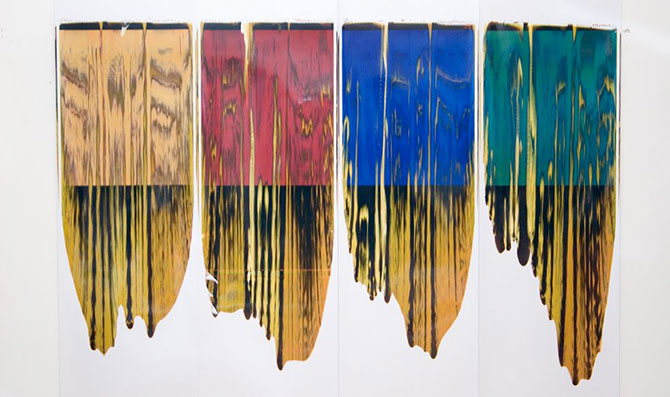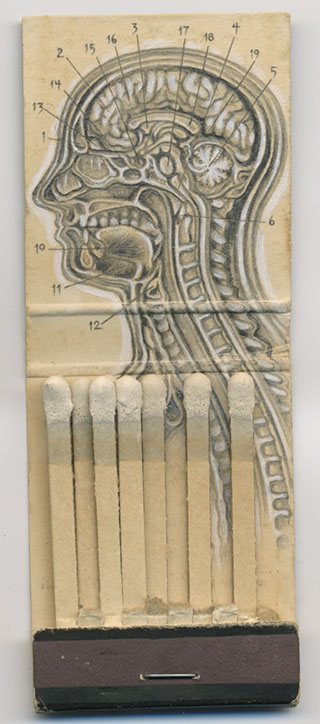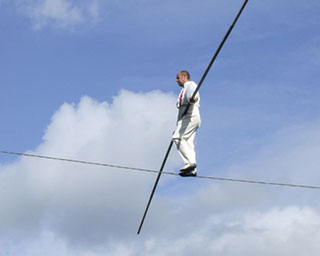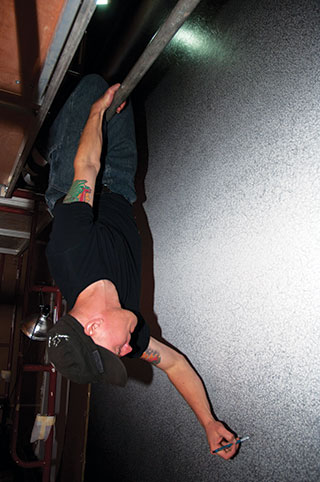Beyond the Beyond
by Gerald Mead and Jack Foran


Art in the interstices of the region's growing biennial
With more than 100 artists—about 70 percent of whom are associated with this immediate region—spread throughout 25 sites including our three art museums, numerous galleries and various other community locations, the third edition of Beyond/In Western New York opening virtually everywhere the weekend of September 23-25 and remaining on view into December is unquestionably the dominant art event this fall, and rightly so. This confluence of conscientiously curated art under one banner, organized by the Albright-Knox Art Gallery in cooperation with over a dozen area curators, is an aesthetic feast that should be consumed in its entirety.
The only downside is that a number of other worthy presentations may fall under the shadow of Beyond/In. In an effort to prevent that from happening, here are some other noteworthy fall exhibitions:
• Reduced and Reclaimed, on view at Dog and Pony Projects through October 8, is the Buffalo debut of work by Gina Alvarez from St. Louis and Bob Jones from Milwaukee. Brought together by gallery founders Rebekah Champ and Tim Roby (themselves Buffalo transplants), Alvarez and Jones both transform mundane, often utilitarian materials into intriguing specimen-like sculptural objects, and embody the gallery’s mission to show artists whose work “blurs the boundaries of the media they work in.” This small new gallery at 561 Forest Avenue is one to watch (www.dogandponyprojects.com).
• Other exhibition spaces of the DIY variety include 464 Gallery and the recently opened Blink Gallery next to it—both converted storefronts operated by the entrepreneurial artist Marcus Wise—that are vital components of the revitalization of that stretch of Amherst Street in the Black Rock neighborhood. Amidst their highly prolific exhibition schedule is Spectrum 720: A Look into the World of Digital Infrared Photography, consisting of images by Buffalo artist Caroline Bronckers that will be presented in Blink Gallery from September 24 to October 14. If you are unfamiliar with the fascinating and characteristically unworldly appearance of infrared images, you should check it out.
• Mark Lavatelli is a rarity among artists since he specializes in encaustic painting, an infrequently practiced, ancient technique utilizing beeswax mixed with dry pigment as a painting media. Arboretum, on view at Indigo Art September 3-26, will include a number of Lavatelli’s schematically structured interpretations of natural subjects. His recent inclusion of stenciled text (identification of landscape elements and weather phenomenon) into his paintings and monotypes provides additional layers of meaning to these already highly compelling works. The artist will discuss his work on September 18 at 1pm.

The Big Show
Get ready for Beyond/In Western New York
Ready for the next big thing? Coming soon to a venue near you.
It’s the more or less biennial exhibit of the work of area artists called Beyond/In Western New York. This time Beyond/In features more than 100 artists, and artworks at a dozen galleries and another dozen or so non-gallery sites. Innovations this year include the variety of venues, works of a small number of non-local artists of national and global repute, and a theme. The theme (and subtitle of the exhibit) is Alternating Currents.
All the artists were invited by curators of the participating galleries, making this a huge collaborative project (a kind of artwork in its own right) among the curators and institutions involved.
In one form or another, and under one name or another, this local artists show has been a fixture of the area art scene since 1934, when the Albright Art Gallery (it wasn’t the Albright-Knox yet) started it up under the title Western New York.
Early on it was a juried show—that is, the works were selected by a panel of jurors—and in 1974 a paltry 37 works were presented, leading to protests by excluded artists and others, and protest exhibitions at other area galleries.
In 1977 the juried format was abandoned and the works—including more works by more artists—were selected by the Albright-Knox curators. The title was also changed to In Western New York.
In 2005 the title was changed again, to Beyond/In Western New York, and artists from outside the eight counties of Western New York—namely, from northern Pennsylvania and southern Ontario—were invited and participated. Also, the curators/selectors list was expanded to include the curators of a dozen other area art institutions.
This year, works will be shown at the other institutions (among other sites). Venues will include the Albright-Knox, Big Orbit Gallery, Buffalo Arts Studio, the Burchfield Penney, Carnegie Art Center, Castellani Art Museum, CEPA, El Museo Francisco Oller y Diego Rivera, Hallwalls, Squeaky Wheel, the UB Art Gallery, the UB Anderson Gallery, the Western New York Book Arts Center, Buffalo and Erie County Historical Society, and the Hi-Temp Fabrication building (at 79 Perry Street, across Perry Street from the HSBC Arena).
More on the individual artists and works as this information firms up.
You can think of the theme, Alternating Currents, as characterizing the art world in general, or the anticipated whole collection of artworks in the exhibit. But the historical reference is to the set of events that put Western New York on the technological/industrial map, the invention of alternating current (AC), and related so-called “War of the Currents” between Thomas Edison, on the one side, and George Westinghouse and his brilliant lieutenant Nikola Tesla, on the other.
Edison held all the patents on direct current (DC), which was the only form of electricity then known. But you couldn’t transmit DC over any great distance. And if you were going to develop massive electricity at Niagara Falls, you had to be able to transmit it to a large market. The large potential market was Buffalo. So you needed a new form of electricity that was transmissible, and that would keep Edison and his patents out of the game. Tesla figured it out for Westinghouse. He developed AC, which uses transformers, which can boost or reduce voltage, enabling transmission. (Hey, according to Ohm’s Law, E = IR. High school physics, first semester.)
To what extent or in what way the various artists and artworks will reflect the theme (or not) will be something to look for. They don’t have to, and reflecting an idea doesn’t guarantee interesting or good art. But the theme is interesting, too.
Kickoff weekend for Beyond/In Western New York will be September 23 to 25. The actual kickoff event will be spectacular, a tightrope walk between the Statues of Liberty on the Liberty Building downtown. More on that and the rest of Beyond/In in later issues.
The art exhibits will be up through mid-January 2011.
—jack foran
• Exhibitions at Nina Freudenheim Gallery rarely disappoint, and Plucking the Rainbow, a group exhibition curated by artist and Hartford Art School photography professor Ellen Carey that is on view September 11-October 20, promises to be spectacular. The exhibition consists of work by artists in varying stages of their careers assembled because of their investigations of color through various media, aptly described by Carey as “a kaleidoscope of new forms and fresh interpretations.” Furthermore, Carey has dedicated the exhibition to Sol Lewitt as an homage to the “chromatic intensity” she has found in his work which in turn influenced her own color infused series of large-format Polaroid images called Pulls, a stunning example of which will be included in the exhibition.
• An opportunity to see vibrant new work by Catherine Parker is always a welcome one, and this fall there are two such occasions. I recommend the short drive out to Meibohm Fine Arts in East Aurora between September 17 and October 16 to see Here and There, an exhibition pairing Parker’s luminescent nighttime scenes with impressionist-like pastels of interiors by Suzann Phelan Denny, a former Buffalo State College professor. Secondly, for one night only (October 6), a series of paintings Parker created inspired by French composer Olivier Messiaen’s masterwork, Quartet for the End of Time, will be on display at Buffalo Seminary for the hour preceding the Buffalo Chamber Players 7:30pm performance of the Messiaen composition.
• At its peak, the Visual Arts Program at Artpark, the New York State park located along the Niagara Gorge in Lewiston, has been described as innovative, radical, and provocative. It was all that and more; looking back, a mind-boggling array of artists who were the seminal figures of that period came to this region to create (mostly temporary) site-specific installations and performances. Artpark: 1974-84 was curated by Sandra Firmin and documents over 200 artists’ projects through original photos, drawings, maquettes, video and film, ephemera, and some material that has been re-fabricated for this exhibit. It opens in the UB Art Gallery on September 24 and will run through December 18. The “not-to-be-missed” event during this exhibit is the October 8-9 conference that will include panel discussions with artists Richard Tuttle and Charles Simonds, just two of the luminaries that were a part of Artpark’s phenomenal history.
• Recalling: Sketches & Reflections of a Journey is an exhibition of drawings and watercolors that noted area watercolorist Rita Argen Auerbach created in her role as the artist of record during the 1986 Chautauqua Institution/Eisenhower Institute Conference on US/Soviet Relations that took place in Riga, Latvia. Presented October 1-29 in the intimate setting of the Peter A. and Mary Lou Vogt Gallery in Canisius College’s Bouwhuis Library, this display of gestural architectural drawings and portraits (many signed by their subjects) of participants offer a unique perspective of this historic moment.
• Graphite drawings meticulously rendered on the inside covers of matchbooks by Jason D’Aquino, inch-long Japanese beetles pieced together from snippets of filmstrip by Esther Neisen, and small oil paintings by Amanda Besl that include lines created by a single cat whisker are among the works that will comprise Thresholds of Visibility: A Survey of Miniature Art, the October 1-November 4 exhibition that I curated for Studio Hart on Allen Street. The other artists included are Bruce Adams, A. J. Fries, Felice Koenig, R. Jeffrey Proctor, Richard Kersting, Coni Minneci, and Alfonso Volo. Sometimes, in art, it is all about size.
• Art Dialogue Gallery (which encompassed the WNY Artist Group in 1995) has been admirably presenting solo and group exhibitions of regional artists’ work since director Don Siuta founded it in 1984. An integral part of that history is its Annual Regional Exhibition (now in its 19th year) that is juried each year by a different art professional. This year, John Massier, the visual arts curator at Hallwalls will jury the exhibition—a wide-ranging survey of work in all media by both emerging and professional artists in the seven counties of Western New York. His choices will be on view October 8-November 13. Ironically, since Massier is also the project director of the Beyond/In Western New York 2010, this group exhibition really is beyond the Beyond.
• The Buffalo & Erie County Historical Society is not an expected art venue, but the exhibition Fact, Fiction & Spectacle: The Trial of Red Jacket looks appealing because it is a multifaceted, interactive analysis and explication of a single monumental (nine-foot-wide) painting in the museum’s collection, The Trial of Red Jacket, painted by John Mix Stanley in the 1860s. According the incoming director Melissa Brown, the painting will be lavishly displayed with velvet drapery and dramatic lighting to “echo the manner that it would have been shown in its heyday when it toured the country and visitors lined up to view it.” This insightful exhibit focusing on both the artist and the content of the painting is on view from October 8 through July 2011.
One final note on last month’s passing of celebrated collector and art patron Charles Rand Penney: I recently referred to this loss as the “end of an era” due in part to the far-reaching effects of Penney’s beneficence. I am personally indebted to Charlie for his friendship, generosity of spirit, inspiration, support, and mentorship over the course of the two decades that I was fortunate to have known him. The Kenan Center, in his adopted hometown of Lockport, held a Celebration of Life Honoring Dr. Charles Rand Penney on September 1 and the Burchfield Penney Art Center, the regional museum that was renamed after him in 1994 in recognition of his major gifts to their collection, will celebrate his life on Thursday, September 2 at 6:30pm.
—gerald mead

The Albright & The Burchfield
Beyond/In Western New York is the big news, but lots of other interesting art shows are planned or ongoing in the galleries through the coming weeks and months.
At the Albright-Knox Art Gallery you can see major art in the making, in a project that will transform the staircase area between the first and second floors into an enormous Sol LeWitt scribble drawing.
LeWitt is one of the giants of the art movement known as Minimalism. His art is about the complexity of simplicity—about how the simpler and more minimalistic it gets, the more complex. Basically by delving deeper into fundamental art issues, such as volume in sculpture, and illusion in painting and drawing.
The work that will be realized over the next month or so at the Albright-Knox—and you can watch it happen—is a wall drawing consisting of pencil scribbles of varying densities that will ultimately read as a huge system of industrial forms. Cylinders, pipes.
A team of four master draftsmen from LeWitt’s studio will direct a crew of 11 artists/artisans who will do the actual scribbling on the walls. A LeWittean principle was that the concept was pre-eminent. Once the concept was developed and established, others could produce the piece. “The idea becomes the machine that makes the art,” he said.
LeWitt conceived and developed the piece specifically for the Albright-Knox staircase following discussions with Albright-Knox Director Louis Grachos in 2006, just before the artist’s death the next year.
In conjunction with the staircase project, LeWitt works from the gallery permanent collection are on display in the corridor link to Clifton Hall. These include drawings, artist’s books, and sculpture, and provide an overview of the artist’s lifetime production and preoccupations. Also on display is the artist’s three-dimensional model of the staircase piece.
Other up-and-coming exhibits over the next months at the Albright-Knox include: a celebration of the Buffalo Sabres on occasion of team’s 40th year of triumphs and defeats and indignities; an exhibit of modern and contemporary artists and artworks concerned with landscape, to which a number of local artists will be asked to respond their own works and own selection of responsive works from the permanent collection; an exhibit of video art featuring installations by 15 or so different video artists.
Meantime, the Burchfield Penney Arts Center will be collaborating with the Buffalo and Erie County Historical Society in a show of 19th- and 20th-century paintings from the historical society’s collection well worth wider viewing. Part of the focus of the exhibit will be on how the historical society paintings—mostly with a distinct local connection, in terms of subject matter and/or the artist—reflect general (that is, basically, European) artistic styles and innovations of the pre-modern and early modern periods. Time Share: An Historic Art Collaboration runs October 23-November 12.
Among other upcoming shows at the Burchfield Penney is an exhibit centered around a Charles Burchfield “haunted house” painting that he called Haunted Twilight. The painting, from the gallery’s permanent collection, depicts an abandoned and dilapidated house near his childhood home in Ohio and spooky surroundings, including trees that look like they could grab you if you got close enough. It was one of a number of works he did through the years displaying a similar sensibility, and tying into his signature theme of animistic forces in nature and whatever once was nature and will one day return there. Reminiscing about this house, Burchfield said, “at late twilight flying squirrels, who spent the daylight hours in the attic of the house, would come out one by one, fly to the base of the pine tree, scramble to the top, and then glide to a woods nearby.” Bats must have shared the attic space with the flying squirrels. You see what look like bats in the picture, and even what looks remarkably like the Warner Brothers version of the Tasmanian devil. Charles E. Burchfield: Haunted Twilight runs September 11-January 23.
A concurrent exhibit on Burchfield is called Think About the Medium, and it looks to be basically about artistic technique. And specifically—this is one of the areas it looks like it will get into—how Burchfield managed to do with watercolors what another artist might only endeavor with oils.
Another exhibit is on high school student hairstyles, as displayed and catalogued by students at the Buffalo Academy for the Visual and Performing Arts. Artist Julian Montague conceived and directed this project.
Meanwhile, continuing at the Burchfield Penney are Bethany Krull’s Dominance and Affection exhibit, about pets and porcelain; James C. Litz’s idyllic folk art paintings and constructions; and, held over, Julie Lewitzky’s whimsical toddler play area; and Ben Perrone’s War Ongoing Project.
—jack foran

Others Beyond the Beyond
The Castellani Museum has scheduled two visual arts shows unconnected with Beyond/In Western New York this fall. Hallwalls has scheduled a number of musical and spoken-word presentations. Queen City Gallery has a one-artist paintings show set for the end of the month. And Squeaky Wheel has a video presentation set for this weekend.
Fly Me to the Moon, a show of prints, paintings, and sculpture on celestial themes from the Castellani’s permanent collection, will open there September 19. And Stolen Souls, Willing, a show of pinhole photography portraits by Mark McLoughlin, will open October 3. The allusion in the title is to the primitivist conception that to capture someone’s image is to capture their soul or essence. The Stolen Souls show is part of the Castellani’s Topspin: Emerging Regional Artists series.
Two current and continuing shows at the Castellani are Exploring the Black Line, works of Amanda Wachob, and Creative to Infinity: the Vision Continues, consisting of works by participants in a visual arts program that attempts to combat personal social impoverishment by the use of art as a means of contact with a larger community.
Hallwalls scheduled programs (and dates) are Quarter-Life Crisis, young singers and musicians performing new and fresh musical theater compositions (September 10); Rockpile, poetry and jazz, with visiting poets David Meltzer and Michael Rothenberg and Buffalo jazz trio The Other Side (September 14); opening year five of the Gray Hair Poetry Series, readings by Sally Fiedler and Jimmy Gilliam (September 15); legendary jazz bassist Henry Grimes in performance (September 16); Hallwalls’ Floating Cocktail Party, Allentown Edition (September 16); eclectic jazz/African musical duo Rob Mazurek on cornet and computer and Chad Taylor on drums and percussion (September 17); the Nu Band (pictured above), four musicians playing music of many colors, derived from many sources (September 23); and kicking off season eight of the Exhibit X Fiction series, readings and performance by novelist and audio collagist Davis Schneiderman (September 28). Schneiderman’s novels include Drain and Abecedarium, and forthcoming Blank: a novel.
The Queen City Gallery exhibit, of the abstract and semi-abstract paintings of Tim Raymond, opens September 24.
And the Squeaky Wheel video, entitled Trash Humpers, will be presented September 4 and 5.
—jack foran
blog comments powered by Disqus|
Issue Navigation> Issue Index > v9n35 (Fall Arts, week of Thursday, September 2) > Beyond the Beyond This Week's Issue • Artvoice Daily • Artvoice TV • Events Calendar • Classifieds |









 Current Issue
Current Issue